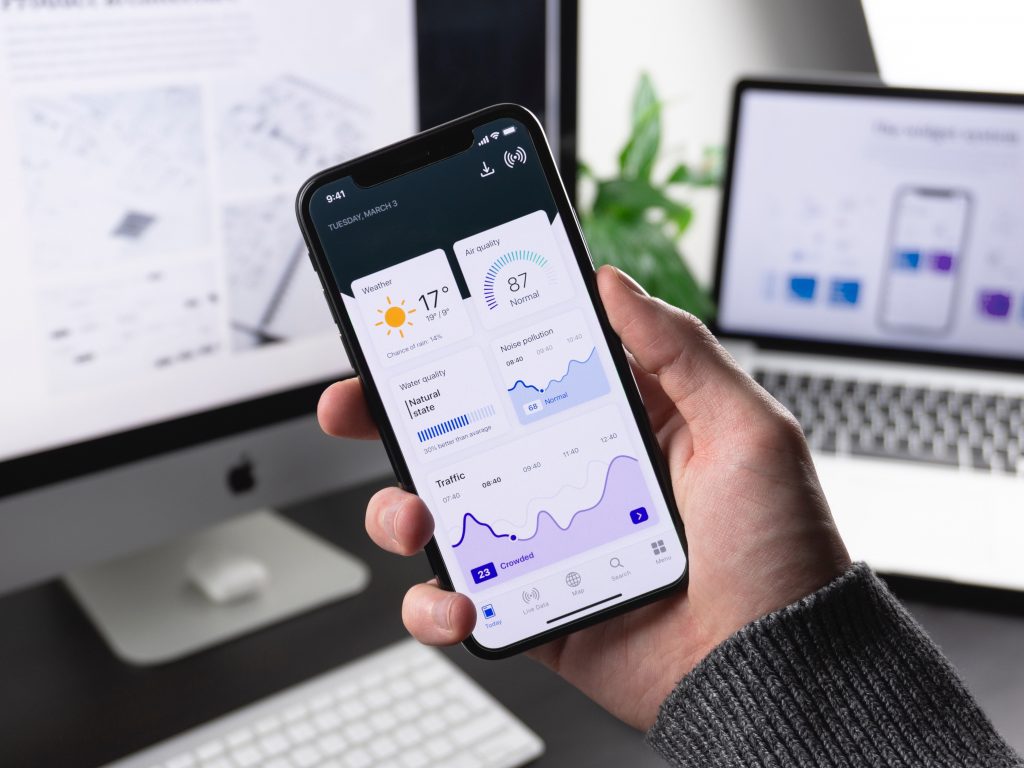Mobile application types | 10 minutes read
Nowadays everybody knows about mobile apps. Each one of us uses several apps per day so it seems like we know everything about this topic. That being said, the questions do start when comes time to start planning an app for our organization.
In our previous blog post, we undercovered the steps of the mobile application development process. Now we want to take a few steps back to explain the basic terminology because misunderstanding can become a barrier in making the right decision on the initial stage.

So, what is a mobile application?
A mobile application is a software program specially created to run on mobile devices such as mobile phone, tablet, mobile watches, etc.
Why people tend to use mobile applications?
Because a mobile application is an easy-to-use, interactive, simple program which helps to increase productivity and engage people. In a mobile application, people can easily schedule events or reminders in a calendar, create and manage contacts, get notifications, read related news, leave feedback, make purchases, and much more.
Mobile apps are distributed in app stores like Google Play or the Apple App Store and can be downloaded and installed directly to your mobile device. Note, that there are other app stores out there (Windows Phone is still kicking around) but their market share is so low, for all purposes, there is only two to really focus on.
So what are the types of mobile applications?
From the technical point, all mobile apps can be implemented with one of the following approaches:
Native apps
Cross-platform toolkit apps
Web-based apps
Hybrid apps
1. Native mobile apps.
The NATIVE APP is a mobile application which is created for the specific mobile operating system. Therefore, this kind of apps is “native” for that system: iOS or Android.
The main advantage of a native app is that they are high performing and ensure the best user experience. Moreover, you get access to all the bells and whistles offered by the operating system. On the other hand, the specifics are that a native app for one operating system cannot be used for a different operating system. For example, an app developed for Android cannot be used on another system like iOS and vice versa. An individual native app must be implemented separately for each operating system. For organizations, it means that native apps require more time and more budget for development because actually, you pay for roughly twice the work. That being said, there are some tricks to reduce the costs here but that will be for another article.
2. Cross-platform toolkit mobile apps.
This kind of apps is built with open-source mobile application frameworks like React Native or Xamarin to perform on both Android and iOS platforms. The advantage of the CROSS-PLATFORM solution is that your organization gets one application with the ability to work on several different platforms which can reduce costs and implementation time. The disadvantage is that in many cases, the user experience and performance is less than desirable.
3. Web-based mobile applications.
A WEB-BASED APPLICATION is an application optimized specifically for a mobile device. Web apps use a browser as a backend to run an app from a specific website. Example of a web app is Google Docs or Gmail accessed via the browser.
4. Hybrid mobile applications.
HYBRID MOBILE APPLICATIONS are created with a mix of either web-based and native technologies or web-based and cross-platform or cross-platform and native.
This kind of platform is relatively faster to develop and less expensive than native development. On the other hand, the complexity can lead to issues (bugs) and also different user experience within the same user interface depending on the view (screen) accessed by the user.
Furthermore, hybrid mobile application development requires multi-disciplinary software expertise from the mobile application development firm.
From the customer point of view, all applications can be divided into 2 main categories:
custom mobile applications,
customized mobile applications.

A CUSTOM MOBILE APPLICATION is an app that was tailored for a definite customer according to its specific business requirements relating to functionality, performance, technical capabilities, etc. A custom mobile app can be implemented with any of the approaches mentioned above. It is up to the mobile development firm to decide in coordination with the customer what technology will work best to meet the expectations.
It is the same as if you have decided to buy a suit. If you ask a tailor to create a suit particular for you, the suit that you will get is completely customized for you. Simultaneously, the costs and the time to produce a custom suit can be significant. The same rule works for a custom mobile application.
In contrast, if the requirements for a mobile application are mostly typical for a specific industry, do not require any unique functionality, then a CUSTOMIZED MOBILE APPLICATION will work perfectly in this case. A customized mobile application may explore some CMS platform based on hybrid software technology and offer a definite number of mostly useful modules for a particular industry. The mobile application performance is fully customized according to requirements and brand standards and the back-end system is optimized for a definite market category, that is easy to manage.
Return to our example with the suit. If you decide to go to the store to buy a suit, you can choose the style, the color, the size or other available features that the store offers. They can make some alterations but probably can’t change the type of material used. You probably will find a perfect, totally customized suit that fits you, and you will be happy with. Moreover, you will be happy with the timing and costs as well. The same rule works for a customized mobile application.
In practice, for associations, cities, towns, and museums it would be more efficient to use a platform or customized mobile applications which benefit them in terms of time and production costs. While big businesses, large organizations with specific requirements and more liberal budgets will probably take advantage of the custom mobile application route.



Share This Article